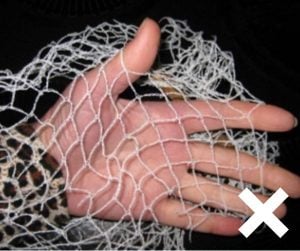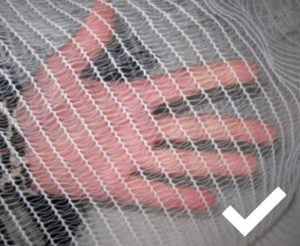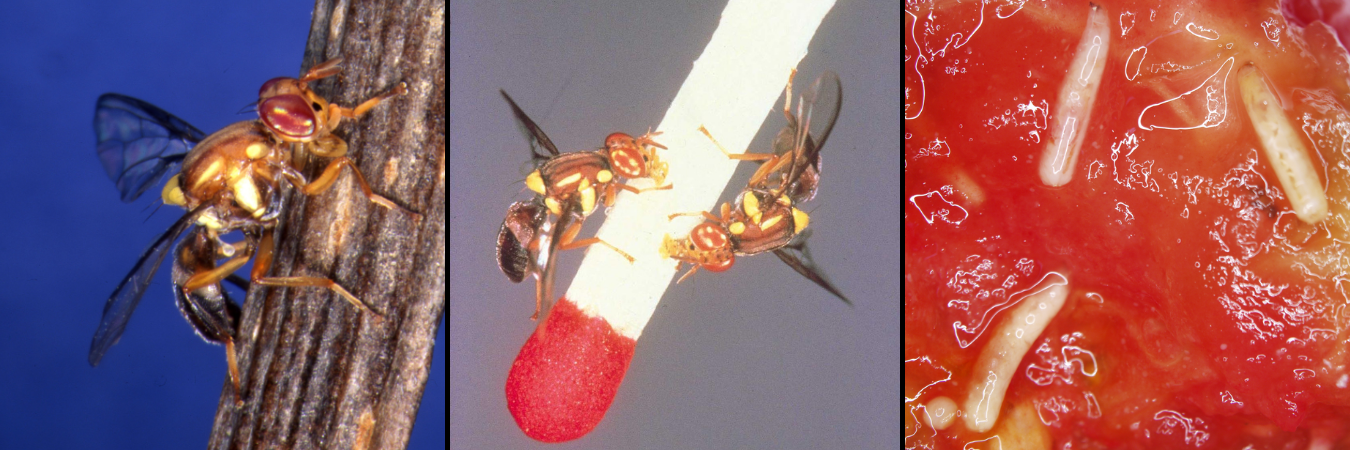Queensland fruit fly (QFF) (Bactrocera tryoni) is a significant pest which can infest many different types of fruit and fruiting vegetables, making them inedible. It is estimated QFF can cause $300 million worth of damage to the horticulture industry in Australia.
Your support in acting fast to treat QFF on your property can help to not only control these pests in your garden, but also to prevent the spread to other properties. Before we get into some of the ways to protect your garden, let’s take a look at what QFF looks like and what to do if you spot signs of an infection in your fruit.
How do I identify QFF?
Adult QFF are approximately 7mm long and reddish-brown in colour, with distinct yellow markings. Signs of fruit fly activity include detection of small puncture marks on the skin of the fruit. Before QFF become adults they go through 3 other stages:
- Egg – around 1mm in size, making it hard to identify them inside the skin of fruits.
- Maggot (larva) – creamy-yellow, and growing up to 9mm long, the maggots begin feeding on the fruit, causing it to rot from the inside.
- Pupa – maggots burrow themselves into the soil and turn into hard, brown pupa, until they come out as adult flies and the cycle begins all over again.
Take a look at this video Agriculture Victoria have put together on the life cycle of QFF.
What fruit are hosts to QFF?
QFF can infect many different fruits and fruiting vegetables which are commonly grown by Victoria’s horticulture growers, home gardeners and community gardens. Examples include apples and pears, stone fruit, berries, citrus, capsicum and chillies, eggplant, tomatoes and grapes.
A full list of host fruits can be found on Agriculture Victoria’s website.
How will I know if I have QFF?
Although fruit may look great from the outside, they may be infested and rotting on the inside.
Signs that you have QFF include:
- A sting or puncture marks on the skin of the fruit where the adult female QFF lay the eggs
- Maggots inside the fruit – maggots usually eat towards the centre of the fruit and cause it to rot, although the fruit may look great from the outside
- Adult flies may be seen flying around ripening fruit trees and often rest on the undersides of leaves. Check around head height within trees.
- You can also use a pheromone based fruit fly trap and checking it regularly will let you know whether QFF is active in your area.
How do I control Queensland fruit fly in my garden?
The most effective control method is to use fruit fly netting to prevent female fruit flies from reaching your fruit and vegetables. Drape fine, UV stable mesh over trees or frames made from PVC tubes or stakes to protect fruit after pollination has occurred. Secure nets around the base of the trunk (best if you have had QFF before) or to the ground to prevent QFF from getting inside. Any fruit touching the netting may be stung by QFF, so it’s important to avoid direct contact between the fruit and net. From 1 September 2021 netting must have a size no greater than 5mm x 5mm at full stretch to reduce the risk of wildlife becoming entangled, under the Prevention of Cruelty to Animals Regulations 2019. Further information on these regulations can be found on the Animal Welfare Victoria website.

Figure 1. Example of non-compliant fruit tree netting.

Figure 2. Example of compliant fruit tree netting under new regulations.
It is also really important to keep your garden free from unwanted, fallen and rotten fruit to stop QFF from breeding in your garden. Remove any flowers or developing fruit that you are not protecting using a control method. Prune fruit trees to a height that allows you to easily pick fruit, apply an insect net or spray. Pick and use fruit as it ripens. Don’t leave infested fruit on trees or let it drop to the ground, where the maggots can enter the soil and pupate. Remove unwanted or unmanageable QFF host plants and replace them with non-host, ornamental plants such as native wattles or grevilleas.
Bait sprays or protein traps can be an effective way to attract and kill the flies. There are some sprays and traps available commercially, or you can also make your own liquid traps at home. You can also use insecticides.
If you do find your fruit has been infected, don’t put untreated produce in your compost, rubbish bin or green bin as this will spread QFF to other areas. To stop the life cycle of QFF you can:
- Microwave unwanted fruit or vegetables to kill any maggots.
- Place the produce in a plastic bag, seal the bag and either leave it in the sun for 5 to 7 days or place it in a freezer for 2 days.
You can then discard the produce in your rubbish bin.
What are we doing?
As QFF are a significant threat to Victoria’s horticulture industry, a collaborative approach between government and community is required to control and manage this pest. Together, the Victorian government and community and industry partners implemented a five-year action plan, linking statewide and regional actions. Agriculture Victoria has further information about the 3 key regional action plans in Victoria.
Further Information
Further information on QFF and what to do if you suspect you have an infection can be obtained from Agriculture Victoria.
Bilingual fact sheets available from Agriculture Victoria.

